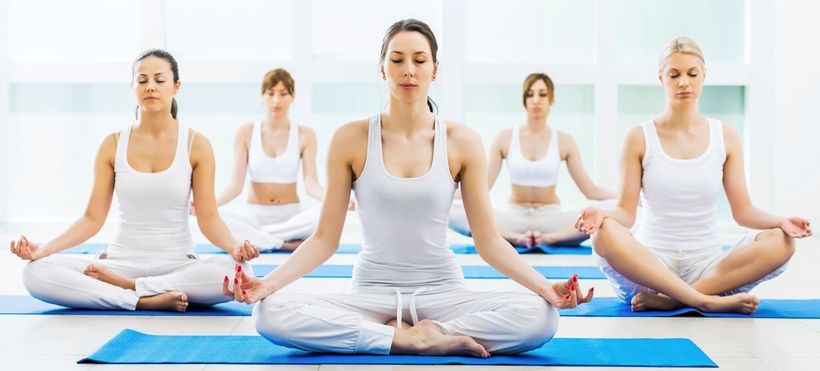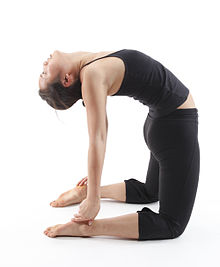YOGA
Yoga is a form of exercise that originated in ancient India and is practised widely across the world today. Yoga not only enhances your physical strength but also contributes largely towards your mental health and spiritual growth.
At the same time, it can improve the overall cognitive functioning, so you do not have to ask yourself how to improve memory anymore. Yoga allows one to concentrate on breathing while slowing down and calming an otherwise agitated mind.
Looking at the popularity of yoga, Hon’ble Prime Minister Narendra Modi suggested at the UN Assembly that yoga be given a special day as it is beneficial for everyone and making it a world event would help in spreading awareness about its benefits. So, on 21st June 2015, World Yoga Day was observed for the first time across the world and has since been celebrated annually.
Yoga not only keeps you fit but also has a lot of long-term benefits when you make it an integral part of your lifestyle.
 |
| Yoga poses |
Some benefits of yoga include:
- Better posture
Yoga helps in keeping the spine erect, enabling you to sit straight and not slouch. It also helps alleviate the stress on your spine, exerted through incorrect posture. Consistent practice of Yoga helps in keeping the spine strong and prevents fatigue.
- Improved bone health
Many postures in yoga require you to lift your own weight which helps in making the bones stronger and helps ward off osteoporosis.
- Increased blood flow
The inverted and twisting nature of Yoga poses wring out the venous blood from the internal organs and allow oxygenated blood to flow. This also boosts the haemoglobin and red blood cells count.
- Improved heart health
When you practice Yoga regularly, you get your heart into the aerobic range. This not only lowers the risk of heart attack but also relieves depression.
- Lowered blood pressure
The savasana (corpse pose) helps people with hypertension. This pose is said to be have resulted in great improvement in people with high blood pressure.
- Improved balance
Yoga involves focusing on holding postures for extended periods of time. This helps in improving your body balance and developing muscle tone.
- Relaxation and sleeping aid
Yoga can help you relieve the stress of modern life and helps you sleep deeper. Yoga encourages you to relax and slow your breath and to focus on the present. It shifts your focus from sympathetic nervous system to parasympathetic nervous system. Restorative asanas and meditation also encourage a turning inward of the senses, which relaxes the nervous system.
- Improved lung health
Yoga draws attention to your breathing pattern and makes you aware of breathing correctly which filters the air, warms it and humidifies it removing the pollen and the dirt, supplying fresh oxygen into the lungs.
- Reduced digestive problems
Yoga like any other physical exercise can ease constipation and lower the risk of colon cancer. The movements that Yoga involves, improve the transport of food and remove waste through the bowels. This helps in getting rid of the waste from the system more effectively.
Eases your pain Yoga can ease your pain and help people who suffer from arthritis, back pain and other chronic conditions. When you relieve pain, you’re in a much better mood and are inclined to be more active.
Yoga can ease your pain and help people who suffer from arthritis, back pain and other chronic conditions. When you relieve pain, you’re in a much better mood and are inclined to be more active.
We all know that yoga brings us peace of mind and relief from a host of physical and stress-related complaints. But the truth is, it can also injure us. According to a 2007 U.S. Consumer Product Safety Commission report, 5,500 yoga-related injuries warranted a doctor’s visit or a trip to the emergency room. While the growing number of relatively inexperienced yoga teachers may be part of the problem, as a student you bear a share of the responsibility, too. Your teacher’s job is to keep you safe and teach a class that’s appropriate for each individual’s skill level. But your job is to choose a class that allows you to listen to what your body needs and to work within its limitations.
Shoulders, wrists, hamstrings, lower back, knees, and sacral iliac joints bear the brunt of most yoga injuries, according to Elizabeth Larkam, a yoga and Pilates instructor in the San Francisco Bay Area.
Some yoga practitioners suffer physical injuries analogous to sports injuries.[258][259][260][261] A survey of yoga practitioners in Australia showed that about 20% had suffered some physical injury while practicing yoga.[258] In the previous 12 months 4.6% of the respondents had suffered an injury producing prolonged pain or requiring medical treatment. Headstands, shoulder stands, lotus and half lotus (seated cross-legged position), forward bends, backward bends, and handstands produced the greatest number of injuries.[258]
Among the main reasons that experts cite for causing negative effects from yoga are beginners' competitiveness and instructors' lack of qualification.[259] As the demand for yoga classes grows, many people get certified to become yoga instructors, often with relatively little training. Not every newly certified instructor can evaluate the condition of every new trainee in their class and recommend refraining from doing certain poses or using appropriate props to avoid injuries.[259] In turn, a beginning yoga student can overestimate the abilities of their body and strive to do advanced poses before their body is flexible or strong enough to perform them.[259][262]
Here are some suggestions for staying injury-free.
Shoulders
The Problem
If your shoulders round forward and you can’t straighten your arms when you lift them overhead, you have tight chest muscles (pectorals) and weak upper back muscles (rhomboids)—and a vinyasa practice of yoga push-ups and arm balances will irritate the shoulder tendons.
The Solution
To strengthen the rhomboids, lie facedown on the mat with your arms by your sides. Lift your upper torso and arms, stretching your arms and shoulders toward your feet. To open the pectorals, lie on your back over a rolled mat, positioned perpendicular to your spine at the lower ribs, with your arms at your sides. Lift your arms up and over your head, as far as they’ll go without pain.
Hamstrings
The Problem
Aggressive forward bending can irritate hamstrings and so can doing the splits before you’re ready. Yoga teachers often tell their students to hug the leg muscles to the bone, which in English means to use your quadriceps (the muscles at the fronts of your thighs) to avoid injuring your hamstrings.
The Solution
If you have a pulled hamstring muscle, don’t do any forward bends unless you really bend your knees. In fact, give that hamstring a rest; ice it and elevate your leg several times a day.
Lower back/SI pain
The Problem
Any practice that focuses on deep twists or straight-legged forward bending can, according to Larkam, put too much stress on the sacral iliac joints (those two bony protrusions at the top of your sacrum) and can even tear the annular fibers that protect the lower back. Asymmetrical poses like parivritta trikonasana (revolved triangle pose) can also aggravate lower back and SI pain.
The Solution
Increase the space between the vertebrae by elongating your spine and the sides of your waist before folding forward, and bend your knees until you learn your limitations, so you stretch your back gently. In twisting poses, engage the core and initiate the twist from there, releasing your pelvis completely. Never go beyond your
Vertebral artery dissection, a tear in the arteries in the neck which provide blood to the brain can result from rotation of the neck while the neck is extended. This can occur in a variety of contexts, but is an event which could occur in some yoga practices. This is a very serious condition which can result in a stroke.[263][264]
Acetabular labral tears, damage to the structure joining the femur and the hip, have been reported to have resulted from yoga practice.[265]
Children
It is claimed that yoga can be an excellent training for children and adolescents, both as a form of physical exercise and for breathing, focus, mindfulness, and stress relief: many school districts have considered incorporating yoga into their Physical Education programs. The Encinitas, California school district gained a San Diego Superior Court Judge's approval to use yoga in Physical Education, holding against the parents who claimed the practice was intrinsically religious and hence should not be part of a state funded program.[266]

International Day of Yoga
On 11 December 2014, the United Nations General Assembly approved a resolution establishing 21 June as "International Day of Yoga",[294] following the call for its adoption by Indian Prime Minister Narendra Modi during his address to UN General Assembly on 27 September 2014.[295][296][297][298][299] In suggesting one of the two solstices, Modi noted that it is the longest day of the year in the Northern Hemisphere and that it has special significance in many parts of the world.[300]
The first International Day of Yoga was observed worldwide on 21 June 2015. About 35,000 people, including Modi and many dignitaries, performed 21 yoga asanas for 35 minutes at Rajpath in New Delhi. The day devoted to yoga was observed by millions across the world.[301] The event at Rajpath established two Guinness records – largest Yoga Class with 35,985 people and the record for the most nationalities participating in it—84.[302]
Health effects
Yoga may improve psychological health during cancer treatment, although more evidence is needed to confirm this possible benefit.[21]Other research indicated that yoga could be useful in addition to other treatments in schizophrenia,[22] and may have positive effects on mental health, although the quality of research to define these effects is low.[247]
In 2015 the Australian Government's Department of Health published the results of a review of alternative therapies that sought to determine if any were suitable for being covered by health insurance. Yoga was one of 17 practices evaluated for which no clear evidence of effectiveness was found.[248] Accordingly, In 2017 the Australian government named yoga as a practice that would not qualify for insurance subsidy, saying this step would "ensure taxpayer funds are expended appropriately and not directed to therapies lacking evidence".[
Adults
While some of the medical community regards the results of yoga research as significant, others point to many flaws which undermine results. Much of the research on yoga has taken the form of preliminary studies or clinical trials of low methodological quality, including small sample sizes, inadequate blinding, lack of randomization, and high risk of bias.[250][251][252] A 2013 review described the effectiveness of yoga for low back pain in the short-term, and moderate evidence that it was effective in the long-term.[253] Another study found an incidence of back injuries from yoga.[254]
Some clinicians have reported studies investigating yoga as a complementary intervention for cancer patients to decrease depression, insomnia, pain, and fatigue and to increase anxiety control.[255] Others have questioned the quality of research and uncertainty in proving this effect.[256]
A 2016 systematic review and meta-analysis found no evidence that yoga was effective for metabolic syndrome.[257]
Yoga should never hurt.
Play It Safe
- Don’t take a class or do a pose that’s too hard for you.
- Ask your teacher to help you modify poses to fit your limitations.
- Never allow a teacher to push you deeper into a pose. If you feel your body resist an adjustment, ask your teacher to stop.
- Don’t ever assume anyone knows your body better than you do. Yoga should never hurt.







No comments:
Post a Comment